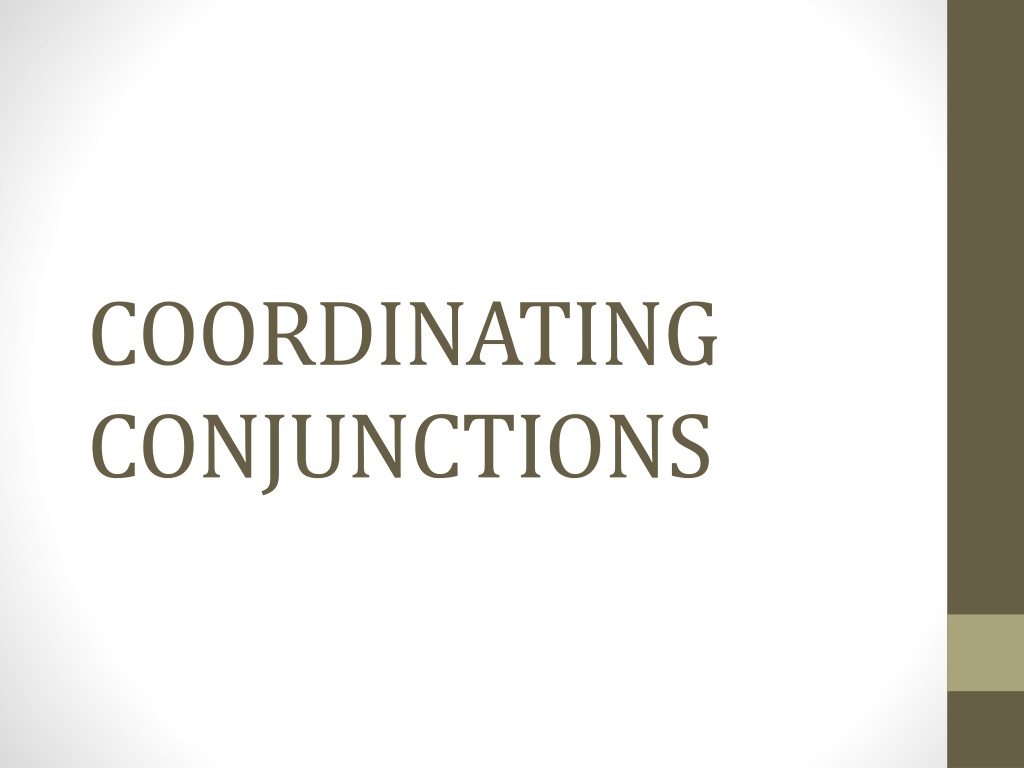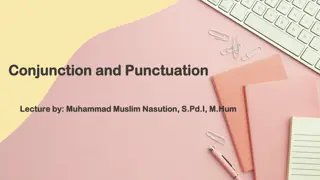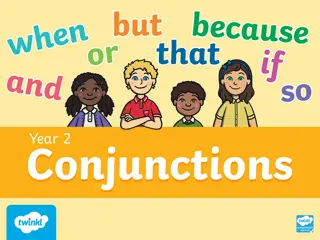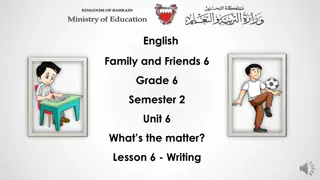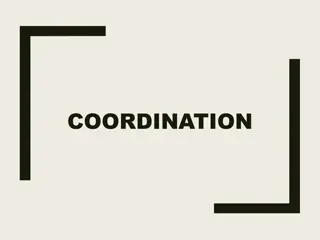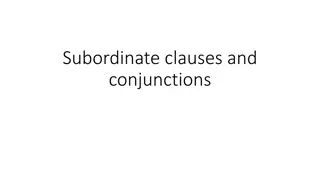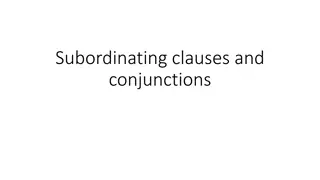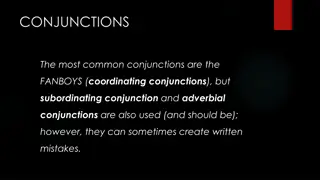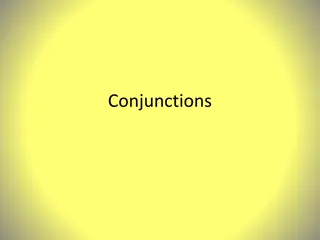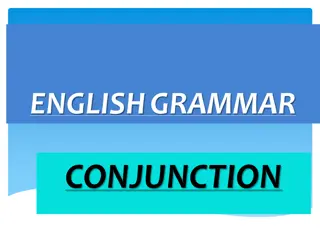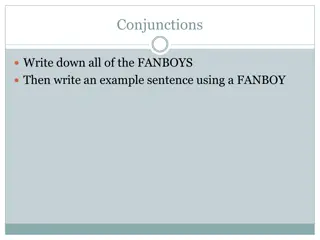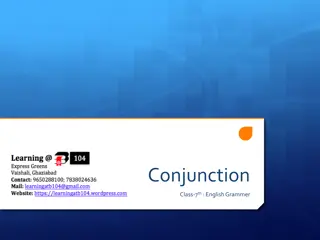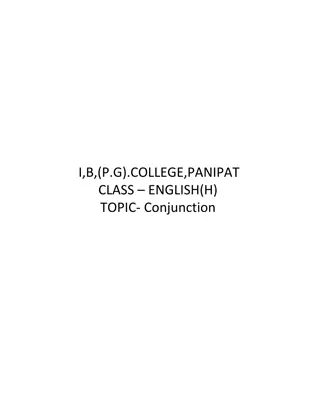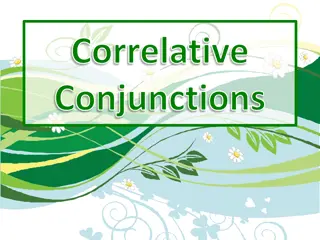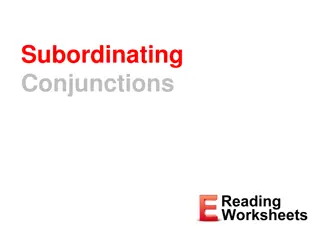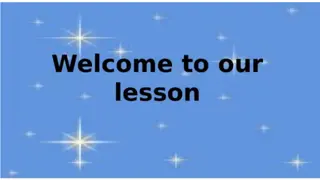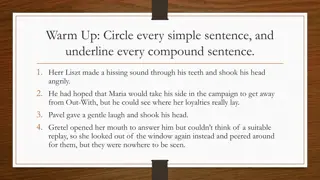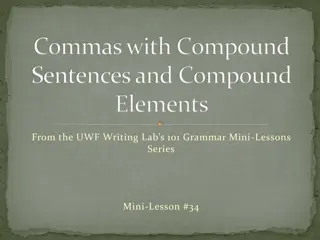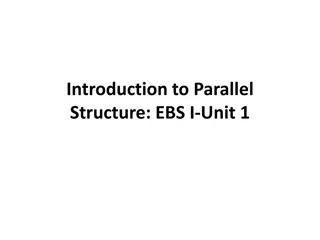Understanding Coordinating Conjunctions and Parallel Structure
Coordinating conjunctions like "and," "but," "or," and "nor" are used to connect words or phrases with similar grammatical functions. This creates parallel structure in sentences, ensuring clarity and cohesion. Using examples, the concept of parallel structure with coordinating conjunctions is explained along with the correct usage of commas in such structures. An exercise highlights applying these principles for practice.
Download Presentation

Please find below an Image/Link to download the presentation.
The content on the website is provided AS IS for your information and personal use only. It may not be sold, licensed, or shared on other websites without obtaining consent from the author. Download presentation by click this link. If you encounter any issues during the download, it is possible that the publisher has removed the file from their server.
E N D
Presentation Transcript
COORDINATING CONJUNCTIONS
Parallel Structure One use of a conjunction is to connect words or phrases that have the same grammatical function in a sentence. This use of conjunctions is called parallel structure. The conjunctions used in this pattern are and, but, or, and nor. These words are called coordinating conjunctions.
(a) Steve and his friend are coming to dinner. In (a): noun + and + noun (b) Susan raised her hand and snapped her fingers. In (b): verb + and + verb (c) He is waving his arms and (is) shouting at us. In (c): verb + and + verb (The second auxiliary may be omitted if it is the same as the first auxiliary.)
(d) These shoes are old but comfortable. In (d): adjective + but + adjective (e) He wants to watch TV or (to) listen to some music. In (e): infinitive + or + infinitive (The second to is usually omitted.)
Parallel Structure: Using Commas a) Steve and Joe are in class. (b) INCORRECT PUNCTUATION: Steve, and Joe are in class. No commas are used when and connects two parts of a parallel structure, as in (a).
(c) Steve, Joe and Rita are in class. (d) Steve, Joe, and Rita are in class. (e) Steve, Joe, Rita, Jan and Kim are in class. (f) Steve, Joe, Rita, Jan, and Kim are in class. When and connects three or more parts of a parallel structure, a comma is used between the first items in the series. A comma may also be used before and, as in (d) and (f). The use of this comma is optional (i.e., the writer can choose).* NOTE: A comma often represents a pause in speech.
Exercise 6, p. 354. 2. Molly is opening the door and (is) greeting her guests. 3. Molly will open the door and (will) greet her guests. 4. Linda is kind, generous, and trustworthy. 5. Please try to speak more loudly and (more) clearly. 6. He gave her flowers on Sunday, candy on Monday, and a ring on Tuesday. 7. He decided to quit school, (to) go to California, and (to) find a job. 8. I am looking forward to going to Italy and eating wonderful pasta every day. 9. The boy was old enough to work and (to) earn some money. 10. I should have finished my homework or cleaned up my room. 12. I have met his mother but not his father. 13. Jake would like to live in Puerto Rico but not in Iceland.
Exercise 10, p. 357. 1. By obeying the speed limit, we can save energy, lives, and money. 2. My home offers me a feeling of security, warmth, and love. 3. The pioneers hoped to clear away the forest and plant crops. 4. When I refused to help Alice, she became very angry and shouted at me. 5. When Nadia moved, she had to rent an apartment, make new friends, and find a job. 6. All plants need light, a suitable climate, and an ample supply of water and minerals from the soil. 7. Slowly and cautiously, the firefighter climbed the burned staircase. 8. On my vacation, I lost a suitcase, broke my glasses, and missed my flight home. 9. With their keen sight, fine hearing, and refined sense of smell, wolves hunt elk, deer, moose, and caribou. 10. When Anna moved, she had to rent an apartment, make new friends, and find a job. 11. The Indian cobra snake and the king cobra use poison from their fangs in two ways: by injecting it directly into their prey or (by) spitting it into the eyes of the victim.
Paired Conjunctions: Both . . . And; Not Only . . . But Also; Either . . . Or; Neither . . . Nor (a) Both my mother and my sister are here. Two subjects connected by both . . . and take a plural verb, as in (a).
(b) Not only my mother but also my sister is here. (c) Not only my sister but also my parents are here. (d) Neither my mother nor my sister is here. (e) Neither m y sister nor my parents are here. When two subjects are connected by not only. . . but also, either. . . or, or neither. . . nor, the subject that is closer to the verb determines whether the verb is singular or plural.
( f) The research project will take both time and money. In (f): both + noun + and + noun (g) Sue saw not only a fox in the woods but (also) a bear. In (g): not only + noun + but also + noun (h) I ll take either chemistry or physics next quarter. In (h): either + noun + or + noun ( i ) That book is neither interesting nor accurate. In (i): neither + adjective + nor + adjective Notice the parallel structure in the examples. The same grammatical form should follow each part of the paired conjunctions.* *Paired conjunctions are also called correlative conjunctions.
NOTE: Paired conjunctions are usually used for emphasis; they draw attention to both parts of the parallel structure.
Exercise 13, p. 358. 2. Yes, both the driver and the passenger were injured. 3. Yes, both wheat and corn are grown in Kansas. 4. Yes, the city suffers from both air and water pollution. 6. Yes, not only his cousin but also his mother-in-law is living with him. 7. Yes, I lost not only my wallet but also my keys. 8. Yes, she not only goes to school, but also has a full-time job. 10. Yes, I m going to give my friend either a book or some jewelry for her birthday. 11. Yes, either my sister or my brother will meet me at the airport. 12. Yes, they can either go swimming or play tennis. 14. No, neither her husband nor her children speak English. 15. No, they have neither a refrigerator nor a stove for their new apartment. 16. No, the result was neither good nor bad.
Exercise 15, p. 360. 3. Both Tanya and Beth enjoy horseback riding. 4. Neither Arthur nor Ricardo is in class today. 5. Both Arthur and Ricardo are absent. 6. We can either fix dinner for them here or take them to a restaurant. 7. Both the leopard and the tiger face extinction. 8. Neither the library nor the bookstore has the book I need. 9. We could either fly or take the train. 10. The hospital will neither confirm nor deny the story. 11. Both coal and oil are irreplaceable natural resources. 12. Neither her roommates nor her brother knows where she is.
Separating Independent Clauses with Periods; Connecting Them with AndandBut (a) It was raining hard. There was a strong wind. (b) INCORRECT PUNCTUATION: It was raining hard, there was a strong wind. Example (a) contains two independent clauses (i.e., two complete sentences). PUNCTUATION: A period,* not a comma, is used to separate two independent clauses. The punctuation error in (b) is called a run-on sentence. In spoken English, a pause, slightly longer than a pause for a comma, separates the two sentences.
(c) It was raining hard, and there was a strong wind. (d) It was raining hard. And there was a strong wind. (e) It was raining hard and there was a strong wind. ( f) It was late, but he didn t care. (g) It was late. But he didn t care. And and but (coordinating conjunctions) are often used to connect two independent clauses.
PUNCTUATION: Usually a comma immediately precedes the conjunction, as in (c) and (f). In informal writing, a writer might choose to begin a sentence with a conjunction, as in (d) and (g). In a very short sentence, a writer might choose to omit the comma in front of and, as in (e). (Omitting the comma in front of but is rare.)
Exercise 18, p. 361. 2. The boys walked (,) and the girls ran. 3. The teacher lectured. The students took notes. 4. The teacher lectured (,) and the students took notes. 5. Elena came to the meeting, but Pedro stayed home. 6. Elena came to the meeting. Her brother stayed home. Exercise 20, p. 362. 1. Janice entered the room and looked around. She knew no one. 2. A thermometer is used to measure temperature. A barometer measures air pressure. 3. Derek made many promises, but he had no intention of keeping them. 4. The earthquake was devastating. Tall buildings crumbled and fell to the ground. 5. Birds have certain characteristics in common. They have feathers, wings, and a beak with no teeth. Birds lay hard-shelled eggs, and their offspring are dependent on parental care for an extended period after birth. 6. The ancient Egyptians had good dentists. Archeologists have found mummies that had gold fillings in their teeth.
Exercise 22, p. 363. Note: Parallel structures that are found within a larger parallel structure are underlined twice. 1. justice, peace, and brotherhood 2. where he stands in moments of comfort and convenience, but where he stands at times of challenge and controversy 3. not the words of our enemies, but the silence of our friends 4. political and moral question . . . oppression and violence . . . oppression and violence . . . revenge. aggression, and retaliation
